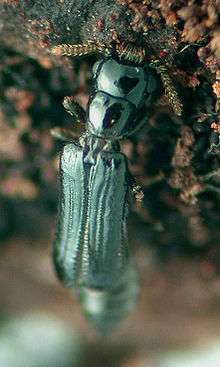Telephone-pole beetle
| Telephone-pole beetle | |
|---|---|
 | |
| Scientific classification | |
| Kingdom: | Animalia |
| Phylum: | Arthropoda |
| Class: | Insecta |
| Order: | Coleoptera |
| Suborder: | Archostemata |
| Family: | Micromalthidae Barber, 1913 |
| Genus: | Micromalthus |
| Species: | M. debilis |
| Binomial name | |
| Micromalthus debilis LeConte, 1878 | |
| Wikispecies has information related to: Micromalthidae |
The telephone-pole beetle (Micromalthus debilis) is a beetle native to the eastern United States, and the only living representative of the otherwise extinct family Micromalthidae (i.e., a "living fossil"). Classification of M. debilis was historically controversial and unsettled. The species, first reported by LeConte in 1878, was long considered one of the Polyphaga, and placed in the Lymexylidae or Telegeusidae, or as a family within the Cantharoidea. However, characteristics of larvae, wings, and male genitalia show that it is in the suborder Archostemata, where it has been placed since 1999.[1]
The beetle is elongated, ranging from 1.5 to 2.5 mm in length, and a dark brown to blackish color, with brownish-yellow legs and antennae. The head is larger than the thorax, with large eyes protruding from either side. The larvae are wood-borers that feed on moist and decaying chestnut and oak logs. They have also been reported as causing damage to buildings and poles (hence the name). The lifecycle is unusual in that the cerambycoid stage of the larva can either develop into an adult female, or give birth to caraboid larvae. The species has been spread to various parts of the world by human commerce, probably in timber.
Reports of the species are infrequent and it is unknown whether they are rare, or common and unrecognized. A recent study by Bertone et al 2016 found telephone-pole beetles in a survey of the indoor arthropod fauna in 50 houses located in and around Raleigh, North Carolina[2]
References
- ↑ Ross H. Arnett, Jr. and Michael C. Thomas, American Beetles (CRC Press, 2001), chap. 2
- ↑ Milman, Oliver (19 Jan 2016). "Hundreds of tiny spiders, lice and more crawling through US homes, study says". The Guardian. Archived from the original (HTML) on 19 Jan 2016. Retrieved 19 Jan 2016.
Matthew Bertone, an entomologist at North Carolina State University, said he was amazed at the variety of species found in what he stressed were “clean and normal” homes in Raleigh, North Carolina. “We were pretty surprised with what we found, such as the smallest wasp in the world, which is just 1mm long,” he said. “I saw a lot of things in homes that I had never seen in the wild before, things we’ve previously tried to trap. There is a weird species of beetle, called telephone pole beetles, where the babies can produce babies. And tiny crickets called ant-loving ants because they are found near ant nests. I’ve never seen one of those before.”
External links
- Wikispecies:Micromalthidae
- Tree of Life page, with pictures and video
- The life cycle of Micromalthus debilis